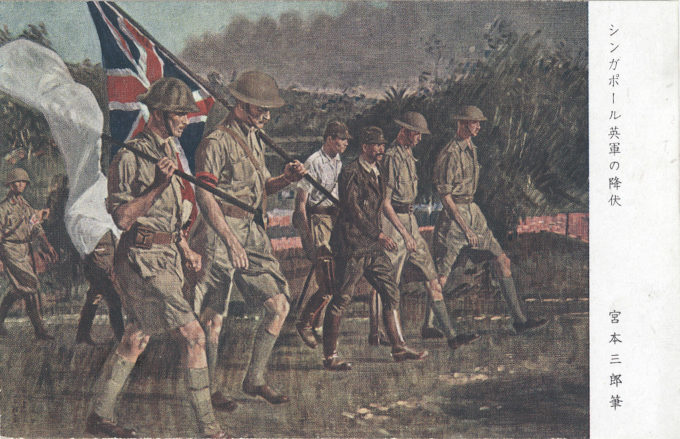“During the day on the 5th Division front, the battle had raged as vioently as in the Keppel Barracks area. Our front line had only been able to advance to the southern end of the reservoir. The troops had never before been under such heavy shellfire, from which the trenches afforded very little shelter.
“The division had attacked from the main road sector supported by the full strength of the ‘Tiger’s Cub’ Tank Brigade, but the troops were finally brought to a standstill at half-past three in the afternoon. Then suddenly, ahead of the most forward troops, who were renewing their assault along the central highway, there appeared a large white flag.
“Major Wylde, an English staff officer, came bearing the flag of truce.”
– Japan’s Greatest Victory; Britain’s Worst Defeat, by Colonel Masanobu Tsuji, 1952

The Surrender of Singapore, 1942. Artist Miyamoto Saburo immortalized the famous scene that occurred at 5 p.m. on Sunday 15th February 1942 when the British surrender party led by General Percival (on right) marched with their Japanese escort to meet General Yamashita at the Ford factory along Bukit Timah Road.
See also:
Conquest of Singapore commemorative postcard, 1942.
The Japanese Occupation of Singapore, c. 1943.
Indian Ocean raid (“Operation C”), Imperial Japanese Navy, 1942.
“Early on the 14th [of February, 1942], General Percival was told that a complete failure of the water supply was imminent. Breaks in the water mains caused by bombing and shelling meant that more than half the supply from the reservoirs was being lost. The supply might last forty-eight hours, perhaps for only twenty- four hours.
“Sir Shenton Thomas warned the G.O.C. of the danger of an epidemic if a large proportion of the population was suddenly deprived of water; but Percival replied that though the shortage was serious it did not make the defence of the city impossible. He intended to go on fighting. Sir Shenton signalled the Colonial Office in London, pointing out that one million people were concentrated within a radius of three miles, with water for only twenty-four hours longer.
“… Singapore City was again heavily bombed and shelled [on the 14th]. Streets were blocked by the wreckage of smashed buildings, broken telegraph poles and tangled wires. The civil hospitals were crowded with wounded, and the ground floors of many large hotels and buildings were being used to house casual ties. The grounds of the Singapore General Hospital were a shambles. Its once smooth, bright green lawns and rich flower-beds were gashed with huge pits dug for the burial of the dead.
“… General Gordon Bennett wrote of Black Sunday the 15th:
‘Today opened with a hopeless dawn of despair. There is no hope or help on the horizon. The tropical sun is sending its steamy heat on to the dying city which is writhing in its agony.
‘The flanks of the Army continue to fall back. The enemy has advanced past Pasir Panjang towards the City. Enemy troop movement along Bukit Timah Road has been shelled by our artillery, as also have enemy troops opposite our own A.I.F. front, but the momentum of the enemy advance goes unchecked.’
“… Lt.-Gen. Percival went to early morning church service at Fort Canning and then called a conference of all senior commanders and key civic officials. The Governor was not present. The G.O.C. told them that the Supreme Commander had granted him the power to capitulate and then they discussed the situation.“In Percival’s opinion there were two alternatives: to counter-attack in an effort to regain the reservoirs and military food depots captured by the enemy at Bukit Timah, or to surrender. His generals were convinced that a counter-attack was out of the question. The troops were too exhausted and dispirited and had insufficient ammunition and supplies.
“Bennett’s diary records: ‘Silently and sadly we decided to surrender.’
– Fortress: The Story of the Siege and Fall of Singapore, by Kenneth Attiwill, 1960

